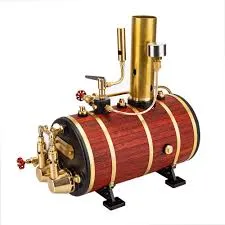
Feb . 06, 2025 04:15 Back to list
biomass fired steam boiler
Adjusting the water level in a steam boiler is a critical task that ensures the system operates efficiently and safely. Not only does it affect the boiler's performance, but it also plays a vital role in preventing dangerous situations like boiler dry firing. With years of industry experience, I've gathered actionable insights that provide a nuanced approach to adjusting water levels with precision.
Addressing Common Issues Low water levels can lead to overheating and potential boiler damage. If adjustments consistently skew towards low water levels, investigate potential causes such as leaks, improper venting, or faulty pressure-reducing valves. Conversely, high water levels might indicate issues with sensors or too frequent auto-feeder activation, leading to inefficient steam production. Document Adjustments Keeping a detailed log of water level adjustments provides invaluable data for long-term maintenance and efficiency analysis. This historical data can help identify patterns or recurring issues that require intervention, enhancing both the longevity and efficiency of the steam boiler. Safety Protocols The complexity and potential hazards associated with steam boilers necessitate strict adherence to safety protocols. Always ensure power to the boiler is off before performing manual adjustments. Moreover, training for key staff on water level management should be ongoing, emphasizing both the expertise and trustworthiness that come with hands-on skills development. Continual Education The landscape of steam boilers and their associated technologies is constantly evolving. Engaging with industry workshops, manufacturer webinars, and technical courses can vastly improve your understanding and ability to manage your boiler's water levels adeptly. By applying these expert strategies to adjust and maintain proper water levels in your steam boiler, you ensure not only the efficient functioning of your system but also uphold the highest standards of safety and reliability. Consistent application of these practices fosters a system that operates seamlessly, providing unmatched performance and peace of mind.


Addressing Common Issues Low water levels can lead to overheating and potential boiler damage. If adjustments consistently skew towards low water levels, investigate potential causes such as leaks, improper venting, or faulty pressure-reducing valves. Conversely, high water levels might indicate issues with sensors or too frequent auto-feeder activation, leading to inefficient steam production. Document Adjustments Keeping a detailed log of water level adjustments provides invaluable data for long-term maintenance and efficiency analysis. This historical data can help identify patterns or recurring issues that require intervention, enhancing both the longevity and efficiency of the steam boiler. Safety Protocols The complexity and potential hazards associated with steam boilers necessitate strict adherence to safety protocols. Always ensure power to the boiler is off before performing manual adjustments. Moreover, training for key staff on water level management should be ongoing, emphasizing both the expertise and trustworthiness that come with hands-on skills development. Continual Education The landscape of steam boilers and their associated technologies is constantly evolving. Engaging with industry workshops, manufacturer webinars, and technical courses can vastly improve your understanding and ability to manage your boiler's water levels adeptly. By applying these expert strategies to adjust and maintain proper water levels in your steam boiler, you ensure not only the efficient functioning of your system but also uphold the highest standards of safety and reliability. Consistent application of these practices fosters a system that operates seamlessly, providing unmatched performance and peace of mind.
Share
Latest News
-
High-Efficiency Commercial Oil Fired Steam Boiler for Industry
NewsJul.30,2025
-
High-Efficiency Biomass Fired Thermal Oil Boiler Solutions
NewsJul.30,2025
-
High Efficiency Gas Fired Thermal Oil Boiler for Industrial Heating
NewsJul.29,2025
-
High-Efficiency Gas Fired Hot Water Boiler for Sale – Reliable & Affordable
NewsJul.29,2025
-
High Efficiency Biomass Fired Hot Water Boiler for Industrial and Commercial Use
NewsJul.29,2025
-
High-Efficiency Biomass Fired Hot Water Boiler for Industrial Use
NewsJul.28,2025
Related PRODUCTS
Copyright © 2025 HEBEI HONGZE BOILER MANUFACTURING CO., LTD. All Rights Reserved. Sitemap | Privacy Policy






















